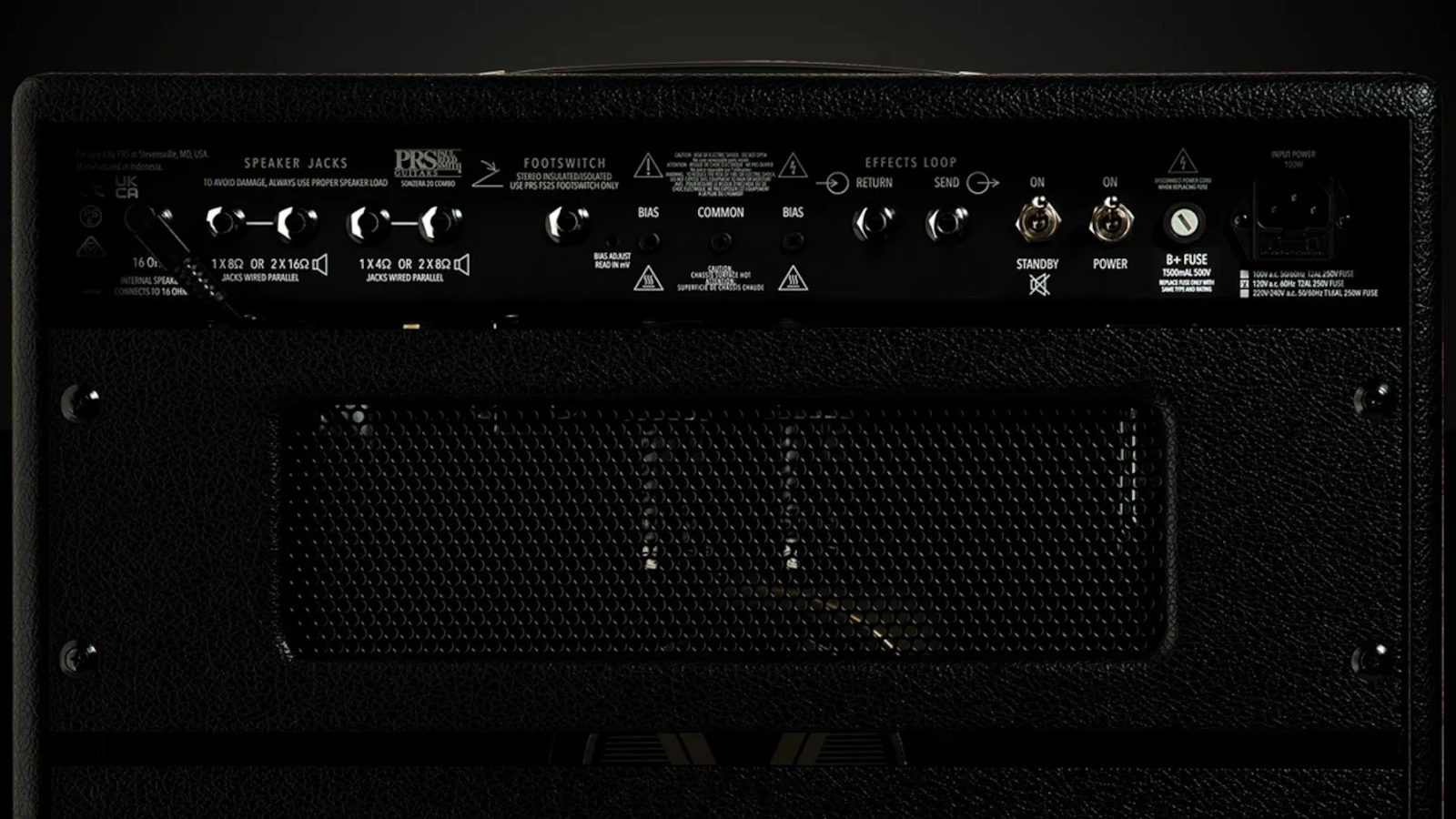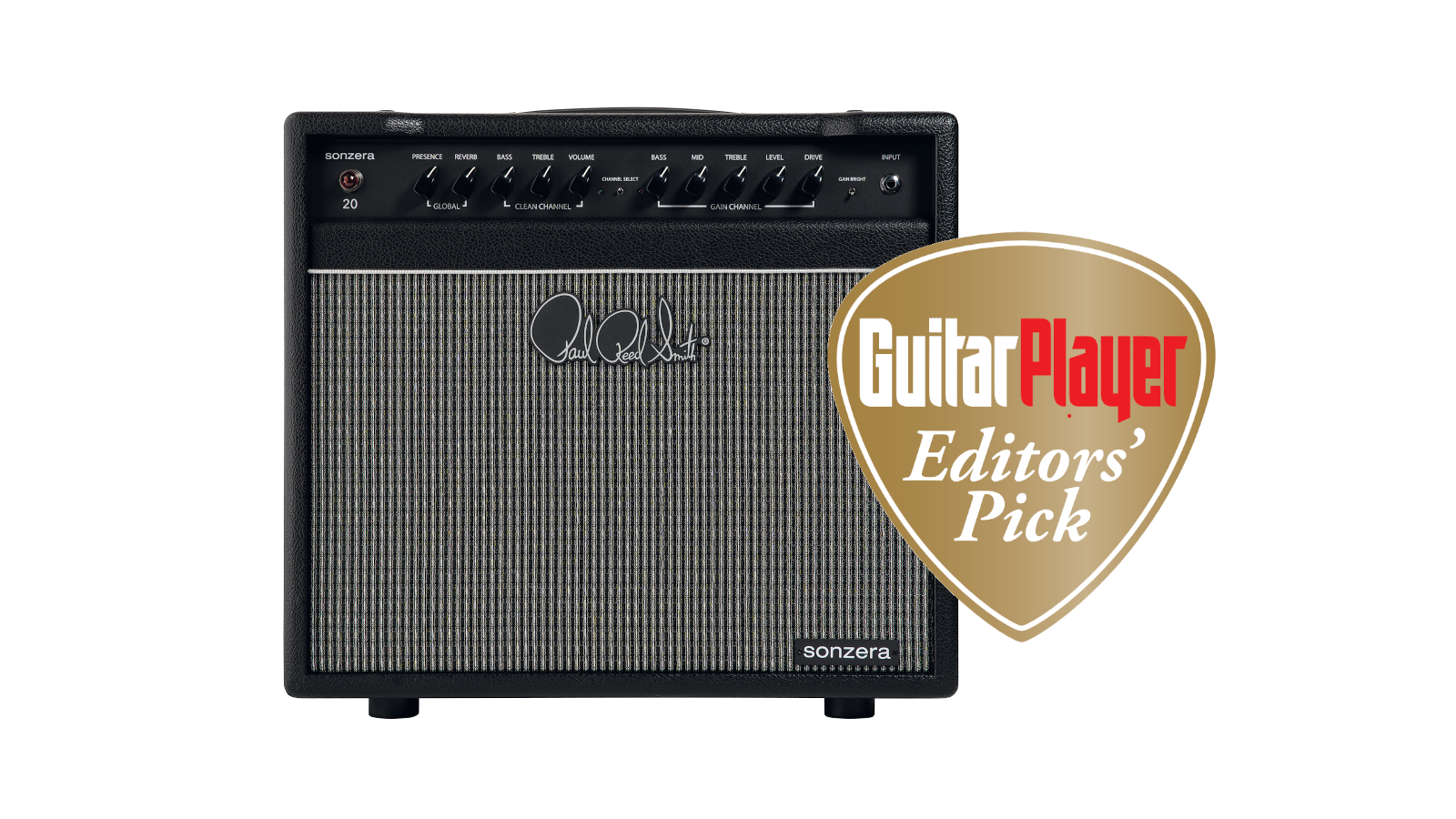GuitarPlayer Verdict
A versatile and great-sounding amp by any standard, and it’s all the more impressive given its price
Pros
- +
A great-sounding amp at the price
- +
Boasts a cleverly conceived feature set
Cons
- -
Clean channel requires an overdrive pedal to push it into breakup
- -
Tapers of the volume and level controls might take some getting used to
You can trust Guitar Player.
An American-voiced amp with a Portuguese name, the Sonzera 20 was recently re-released by PRS, and on paper at least it does appear to fill a crucial space in this Maryland-based maker’s lineup. The 20-watt, black-panel, 1x12 reverb combo has been a seminal template ever since Fender’s legendary Deluxe Reverb hit the scene in 1963.
PRS amp designer Doug Sewell has not only refined the amp’s voicing but has also redesigned the printed circuit board
Add a foot-switchable gain (lead) channel, effects loop, and external bias adjustment facilities to the feature set, and if it lives up to its name in the tone department – sonzera being slang for cool sound – it’s almost certain to be a winner at this price. Even though the 2023 Sonzera 20 comes in at approximately $200 more than the original 2017 release, the sub-$1,000 price tag appears extremely reasonable, from a quick assessment.
It looks to be even more of a bargain when you learn that PRS amp designer Doug Sewell has not only refined the amp’s voicing but has also redesigned the printed circuit board (PCB) for lower noise and improved durability, upgraded component specifications, and made the cabinet build more rugged, along with overhauling the combo’s look.
Regarding the styling, I feel the black Tolex with silver grille and piping is a winner, and the 19-by-18-by-10.5-inch combo looks sleek, timeless and ready for business.

Despite its American inspiration, the Sonzera 20’s control panel is laid out British style, with the signal flowing leftward from a single input at the far right of the fascia. From here, we first approach the Gain channel with its own bright switch, followed by controls for drive, level, treble, mid and bass. A front-panel channel-selector toggle follows, with the Clean channel’s volume, treble and bass after, then global reverb and presence.
Chinese construction has helped to keep the Sonzera 20’s price at this level, but the re-released combo reveals a robust build and sturdy components nonetheless
On the back, right to left, are the power and standby switches, loop send and return, output-tube bias checkpoints and adjustment pot, the TRS foot-switch jack (a two-button foot-switch for reverb and channel selection is included), and five speaker outs: one for the onboard 12-inch Celestion V-Type at 16 ohms, two eight-ohm and two four-ohm.
Chinese construction has helped to keep the Sonzera 20’s price at this level, but the re-released combo reveals a robust build and sturdy components nonetheless. Inside the chassis this means a PCB and consumer-grade parts, naturally, but I’d say it’s on par with most other all-tube amps at this price, and arguably more confidence-inspiring than many.
All the latest guitar news, interviews, lessons, reviews, deals and more, direct to your inbox!
The Sonzera 20 carries four 12AX7 preamp tubes for gain-stage, reverb and phase-inverter duties, along with two 5881s in the output stage (they can be substituted with two short-bottle 6L6GC STRs, if desired).

Sewell tells us the larger output tubes enable a big-amp voice in a lower-output package and are easily regulated by voltage levels and careful transformer design to operate in something of a “permanently power-scaled” state. Used in this way, the bigger output tubes are also likely to enjoy an extended lifespan, which should help reduce maintenance issues.
An amp that more than lives up to the value that its specs-to-price ratio implies
I tested the Sonzera 20 with a Fender 1954 Telecaster Reissue and a Gibson SG Standard with humbuckers, and quickly discovered an amp that more than lives up to the value that its specs-to-price ratio implies.
Sewell points out that the Sonzera 20’s standby control is really an input-mute, so the usual “amp on” background noise will be heard even with that switch still off, but in fully operational mode the noise level is reasonable, even with the Tele’s single-coils.
With either guitar, the Clean channel offered impressive headroom throughout its range, delivering classic snappy, tight and articulate tones in a broad, balanced voice entirely redolent of the ’60s American classics.

While players also loved the original’s ability to be set at the edge of breakup for semi-clean tones that are still dynamic and singing, the Sonzera 20 avoids tipping into clipping all the way up the dial, and maybe just edges toward it at top whack with the SG’s humbuckers applied.
The Gain channel can be dialed down for edge-of-breakup clean-ish tones too, but then you would miss out on the delightfully thick, rich, singing lead voicings available here
But that’s just what we call a pedal platform these days, and as per its design intentions this channel interacts beautifully with a range of overdrive pedals – including the Wampler Tumnus Deluxe, Origin M-EQ Driver and a Victory The Duchess that I tried with it – to enable a “third channel” of sorts, achieving the pushed-cleans and crunch tones that the amp itself lacks.
The Gain channel can be dialed down for edge-of-breakup clean-ish tones too, but then you would miss out on the delightfully thick, rich, singing lead voicings available here, which I found to be some of the most fun tone zones in the entire amp. American leaning, but with a nod toward British stack territory, this channel proved a gutsy rock warrior with surprisingly versatile capabilities, and it was one of the biggest surprises of this new Sonzera 20.

Both the Clean channel’s volume and the Gain channel’s level control can trick you into thinking there isn’t a whole lot of volume available here, given the gradual increase from silent to the high-noon position.
The tube-driven spring reverb is impressive on all fronts
From there, though, things just keep getting proportionally louder on both channels, rather than merely folding into clipping as on many vintage amps, so it’s really more a matter of adjusting your expectations to an evenly tapered potentiometer.
The tube-driven spring reverb is impressive on all fronts: It doesn’t wash out the clarity and attack of your picking, even when maxed out, and it’s a lush and richly atmospheric effect by any measure.
All in all, this is a versatile and great-sounding amp by any standard, and it’s all the more impressive given its $999 price tag.
Given all of the above, the Sonzera 20 earns an Editors’ Pick Award for its achievements.

SPECIFICATIONS
- CHANNELS: 2
- CONTROLS: Gain: drive, level, treble, mid, bass, bright switch. Clean: volume, treble, bass. Global: reverb and presence
- POWER: 20 watts
- TUBES: Four 12AX7 preamp tubes, two 5881/6L6 output tubes
- SPEAKER: 70-watt 12-inch Celestion V-Type
- EXTRAS: Two-button foot-switch for reverb and channel select. FX loop, bias check and adjustment points. Five speaker outs for 4Ω to 16Ω cabs
- WEIGHT: 42 lbs
- BUILT: China
Dave Hunter is a writer and consulting editor for Guitar Player magazine. His prolific output as author includes Fender 75 Years, The Guitar Amp Handbook, The British Amp Invasion, Ultimate Star Guitars, Guitar Effects Pedals, The Guitar Pickup Handbook, The Fender Telecaster and several other titles. Hunter is a former editor of The Guitar Magazine (UK), and a contributor to Vintage Guitar, Premier Guitar, The Connoisseur and other publications. A contributing essayist to the United States Library of Congress National Recording Preservation Board’s Permanent Archive, he lives in Kittery, ME, with his wife and their two children and fronts the bands A Different Engine and The Stereo Field.



